Sorted by date Results 101 - 125 of 132
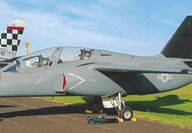
Designed as a basic trainer with light attack capabilities, the S. 211 first flew on 10 April 1981. Powered by a 2,500 pound thrust P&W of Canada turbofan, it has a maximum speed of 414 mph and a service ceiling of 40,000 feet. With four underwing hardpoints, it can carry a variety of bombs, rockets, and gun pods. Only three countries ordered the S. 211: Haiti (4), the Philippines (24), and Singapore (30). Over 60 percent of the airframe was made of composites. The two crew members sit in... Full story
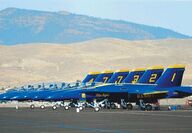
Tom Lymburn The full moon was the only light on the gray gravel of lot 3-the Participants and Media lot. Race crews filtered slowly out of the banquet hangar, last good byes, hugs, slaps on the back, jokes, and joshes delivered, and wended their tired, sunburned ways toward rental cars, dusty pickups, and RV'S. Sawbones team would be taking many ways home-airliner, truck, and race plane. Sue and I trudged toward the gate, past Formula 1 racers being disassembled for trucking home. Wings and... Full story
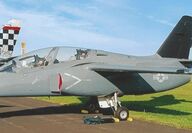
During World War II, the British relied on the United States for transports. Realizing they could be left behind after the war was over, the Barbazon Committee looked at setting requirements for post-war airliners. Some designs, like the huge Bristol Brabazon with eight Centaurus radials and the ten engine Saunders-Roe Princess flying boat, were colossal failures. Only two became serious trend setters. The graceful de Havilland Comet had to overcome some mysterious early crashes before proving... Full story
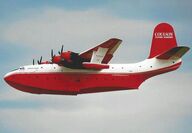
"That should about do it." John set the big camera down and turned to the lap top that rested on the work bench. Another biz jet taxied by the Weeks hangar. Light rain continued its dreary patter on the big hangar's roof. Deftly, he adjusted the contrast to eliminate a tiny bit of glare near the faded letters of the crew bomb tally. At Oshkosh, in 2015, I had run into Atlanta photographer John Slemp by the Stinson. When he showed me a photo from his bomber jacket art project – a photo that w... Full story
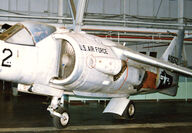
Hawker Siddeley Kestrel FGA. Mk. I (XV-6A) Evolved from the Hawker P.1127, which made successful use of the Bristol Siddeley Pegasus vectored thrust turbofan, the Kestrel paved the way for the V/STOL combat capable, and later battle tested in the 1982 Falklands War, Harrier, that remains in service with the USMC, Italy, India and Spain. Work began in 1958. The first free flight of P.1127 serial number XP831 took place on 19 November 1960. Another prototype and four development aircraft... Full story
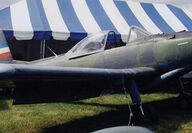
Prior to World War II, Yugoslavia manufactured a number of fighters and floatplanes, plus license manufactured the British Bristol Blenheim bomber and Hawker Hurricane fighter. After the war the aircraft industry's recovery took a number of years. Soko, formed in 1951, began with license manufacture of Westland Whirlwind and Gazelle helicopters. In 1957 it initiated work on the Galeb and Jastreb series of jet trainers and light attack aircraft. Then, in 1966, came the Kraguj, a single seat... Full story
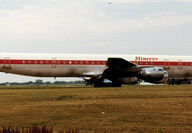
The Concorde was not the first airliner to exceed Mach 1.0. That honor goes to a Douglas DC-8-40 with Rolls Royce Conway engines that broke the sound barrier in a shallow dive on 21 August 1961. First flown at Long Beach on 30 May 1958 by A. G. Heimerdinger, the DC-8 was designed to replace the piston powered DC-6 and DC-7 and compete with Boeing's 707. Somewhat late to the market and without the benefit of military versions like Boeing's KC-135, only 556 DC-8's were built, compared to 856... Full story
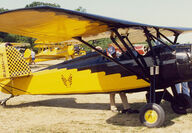
The Davis series of parasol wing monoplanes was built by former WWI pilotWalter C. Davis and the Davis Aircraft Corporation of Richmond, Indiana from 1929 to 1930. Power plants varied from the 60 or 85 hp LeBlond, through the 100 hp Kinner K-5, the 90 hp Lambert, to the 145 hp Warner Super Scarab model that is the subject of this Oshkosh 1988 photo. The Davis won Approved Type Certificate #256 on 8 November 1929, with the Warner version licensed under Group 2 Approval #394 on 21 December 1931.... Full story
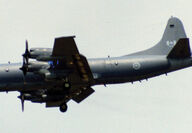
Designed to replace the Wright R-3350 Turbo-Compound powered Canadair CP-107 Argus (remember the May 2003 Mystery Plane?), which had replaced the wartime Avro Lancaster 10, the Lockheed CP-140 Aurora was ordered in July 1976. Wearing serials 140101 to 140118, the Aurora combined elements of the P-3C airframe with S-3A Viking electronics and search gear. With a crew of 11, the CP-140 was powered by four 4910 hp Allison T-56 turboprops. It is fitted out to handle antisubmarine, pollution patrol, s... Full story
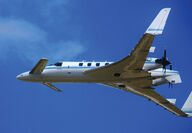
Tom Lymburn We'd just pulled into the parking lot at the hotel in Ripon where we've stayed for the last 25 years when Sue pointed up and asked, "What's that?" The "What" was Golden Wings' Fairchild FC-2W2 flown by Jim Obowa, just making the turn over Ripon to follow the railroad tracks toward Fisk and Oshkosh. Timing. It's all about timing. Whether it's the convergence of the stars or planets or just plain dumb luck, timing. Something that brings together the old and the new, history and the... Full story
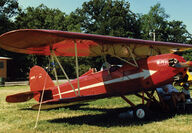
Known as the Bird, Brunner-Winkle Bird, and the Perth-Amboy Bird, this 1929 gem has a lot of history behind it. Luminaries such as Wiley Post, Lee Gehlbach, Clarence Chamberlain, and Milo Burcham all had Birds. The best known owner of a Bird Model BK was Charles Lindbergh who purchased one for $3500 in the fall of 1930 for his wife Anne. It was in NC727Y that she earned her pilot's license, passing her flight test on 29 May 1931. NC727Y still flies, now based in Maryland. Produced under Approved...
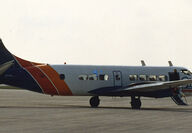
The de Havilland DH 114 Heron, which first flew at Hatfield on 10 May 1950, proved adaptable to stretching and engine changes. Initially powered by four de Havilland Gipsy Queens of 250 to 340 hp, it was later rebuilt with 260 and 340 hp Lycomings. The ultimate modification came in 1969 when Saunders Aircraft of Gimli, Manitoba, reconfigured a Heron Mk. II with a lengthened fuselage, a reengineered wing, and a pair of 715 hp P & W PT -6A turboprops. The fuselage stretch was eight feet six... Full story
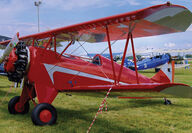
The Vintage Aircraft Association's "Round Engine Rodeo" in 2013 attracted a wide variety of beautiful and rare radial engined classics. Waco, Travel Air, Beech, Stinson, Stearman, Spartan, Grumman, de Havilland, Howard, Lockheed, Douglas - you name it, the great radial engined aircraft were represented. One unique biplane parked a little ways from Greg Herrick's Stinson trimotor that I was ground crew on, was the one of a kind Flaglor High Tow, a 220 hp Continental powered glider tug built by...
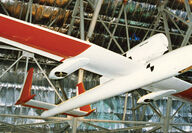
In this day of Predators, Reapers, Global Hawks, and other unmanned aerial vehicles, we forget that aircraft similar in concept have been trialed over the whole course of aviation's century plus evolution. The Boeing YQM-94A is one example. Ordered in 1971 by the U.S. Air Force Aeronautical System Division for high altitude, long RANGE unmanned recon, the YQM-94A and the Ryan YQM-98A, were meant to launch and recover from a fixed runway. Two prototypes of each were ordered. The YQM-94A was...
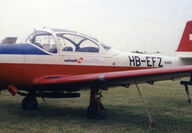
The famous Italian aircraft manufacturer Piaggio has existed in three forms. Begun in 1915 at Genoa by industrialist Rinaldo Piaggio, it built parts for Caproni bombers and Macchi flying boats during World War I. Then it specialized in multi-engined aircraft until the armistice in 1943. Re-formed in 1946, Piaggio built trainers, including the P-148 and P-149, for military use. It was restructured again in 1964. Derived from the two seat P-148 tail dragger that first flew in 1951, the... Full story

The American Helicopter Company was formed in 1947 and produced a small series of pulse jet rotor helicopters beginning with the A-5 "Top Sergeant" in January 1949. This was followed in 1950 by the A-6 "Buck Private." Neither design made it beyond the prototype stage. In 1951 the Army Transportation Corps joined the Air Force in calling for a one man, lightweight helicopter that could be airlifted and used for observation or rescue. In June 1951 a contract was awarded to the American Helicopter... Full story
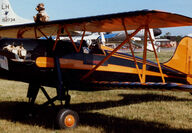
This month's winner Dave Gunderson of Mora wrote, "This little beauty is a Hannaford Bee-model D-1, completed in 1981 by homebuilder John Bright." Joe Connell of Stewartville wasn't fooled either, "I have a Kitfox and used to share a hangar at the Rochester Airport with John Hanson who built a Parakeet." Barry Taylor of Ottumwa, Iowa, called it, "One of my favorite airplanes." Graydon Carlson found the answer in a 1955-1956 issue of Air Progress magazine! Did you note the two different spellings...
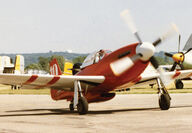
I checked the 300 mm on my Nikon for the third time and made sure the filter was clean. Arrival of the honored guest was only minutes away. She was an old friend. I'd first spotted her sitting among the clover on the east side of Flying Cloud Airport when I was finishing my private pilot license at Beech Aero. There was no mistaking her perfect lines. It was April 1983. Another photographer by the gas pumps pointed and we listened, then watched as Doug Rozendaal made an overhead approach,... Full story
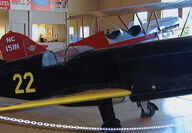
In the years before the Second World War, air racing was the catalyst for improvements in engines, fuels, lubricants, streamlining, and structure. Part of that development encompassed the famous Menasco powered racers of the 1930s. An air cooled, inverted, four or six cylinder inline engine, ranging from the 90 hp Pirate to the souped up 315 hp Buccaneer, they powered racers built by Bennie Howard, Clayton Folkerts, Lawrence Brown, Art Chester, and Keith Rider. Herschel Smith in A History of... Full story
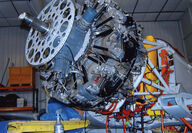
I snugged the crotch straps and aligned the shoulder harness - careful to keep the D-ring uncovered. CLIP. And CLIP again. Stage one done. Now for the four-point harness. Another set of shoulder straps - then the wide lap belt with the quick release, locked and set- almost. The plugs for my trusty David Clarks are behind my left elbow. I ease the straps and Wayne deftly reaches under my arm pit and plugs in and I'm good. Good and tight. My old Nomex zipped. Velcro cuffs tight. Flying gloves... Full story
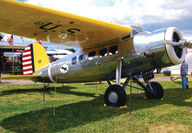
My allergies are acting up. I wipe my nose with a rumpled cotton handkerchief that normally is stuffed in my back pocket. Sue grimaces at this practice, but wisely says nothing. I start the Jetta, trip the wipers, fore and aft, to get the dew off the windscreen, and back out, down the steep driveway from the hotel parking lot, and head for Wisconsin 44 at Ripon's 25 mph. Up the long hill, past the old cookie plant, workers carrying lunch pails, walk into the side entrance, past the sweet corn...
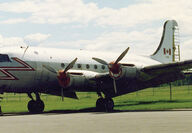
Before the end of WWII, Trans-Canada Air Lines foresaw the need for a domestically produced airliner. After considering the Douglas and Lockheed products, the decision was made to adapt the DC-4 with 1760 hp Rolls Royce Merlin 620 engines and a pressurized fuselage. The RCAF also expressed interest, but without the pressure cabin. After the war, Canadair brought C-54 tooling and components from Douglas's Chicago plant. Initial DC-4M and C-54GM production used many Douglas built parts. The... Full story
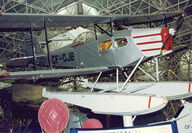
Built using the wings, tail feathers, landing gear and engine mount from the DH-82 Tiger Moth mated to a new fuselage, the Fox Moth, capable of carrying four passengers, first flew from Stag Lane on 29 January 1932, attaining its type certificate on 20 May 1932. The prototype, G-ABUO, was shipped to Canada for tests on skis and floats. Registered CF-API, it continued in service until 1950. Ninety-eight Fox Moths were built in the UK, serving small airlines and racing in the King's Cup. The... Full story
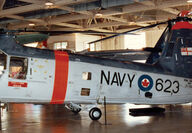
Frank Piasecki founded PV Engineering in 1941. His experimental PV-2 helicopter appeared in April 1943, followed by NACA awarding him Helicopter Pilot Certificate No. 1. The H-21 (the May 2011 Mystery Plane) was followed by the PV-14, which led to the Navy's HUP "Retriever" and the Army's H-25 "Army Mule." Powered by a 550 hp R-975 radial engine, the HUP had a maximum speed of 108 mph and a range of 360 miles. Its useful load with two pilots, was 1650 pounds, four to seven passengers or three...
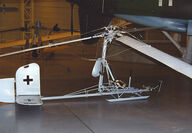
In 1933, Professor Heinrich Focke resigned as Technical Director of Focke-Wulf to purse his interest in rotary winged aircraft. Beginning by license building Don Juan de la Cierva's C.19 autogyro, he worked with aerobatic pilot Gerd Achgelis toward perfecting a practical helicopter. His Fa-223 Drache was one of the few helicopters, along with the Flettner Fl-282 Kolibri and the Sikorski R-4, to see WWII service. In early 1942, the Kriegsmarine asked Focke-Achgelis to design a gyro kite to be...